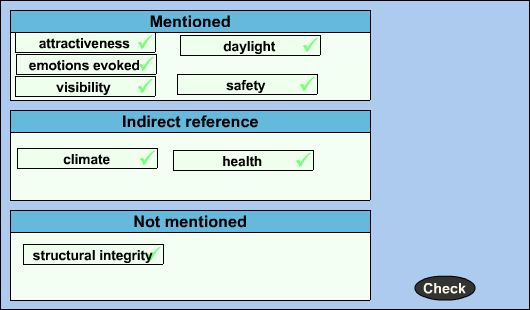

Introduction to lighting for architectural design

Lighting effects
Lighting is a key element in architectural design. For example, in dense urban areas, good lighting used in relation to the scale and importance of the area in question can articulate nocturnal space into smaller ambiences. To illustrate, when you approach an area in a city you will first perceive light from general illumination. As you continue to approach, smaller portions of a space will gradually be revealed and a different (smaller scale) level of the illumination.
In these activities you will explore some of the terminology used for expressing the relationship between lighting and architecture in English at the same time as reading a text about the basic principles of lighting for architectural design. You will also identify common problems and language in relation to architectural design in urban spaces.
Activity 1: Concepts for lighting design
In this activity you are going to consider some basic concepts used in lighting design and the various ways in which they are described.

Instruction
Read the text outlining some basic principles of lighting for architectural design. As you read, make notes in the text area provided of any useful language for discussing lighting design and use a dictionary for any unknown terms. Then check your understanding of the text, first by matching points (select an example of spoken language from the list on the left by clicking on it. Then click on the type of feature that matches with it from the list on the right). Secondly, group concepts according to the text by moving them into a box. When you have finished, read the feedback.
Comprehensive lighting design requires consideration of the amount of functional light provided, the energy consumed, as well as the aesthetic impact supplied by the lighting system. Some buildings, like surgical centres and sports facilities, are primarily concerned with providing the appropriate amount of light for the associated task. Some buildings, like warehouses and office buildings, are primarily concerned with saving money through the energy efficiency of the lighting system. Other buildings, like casinos and theatres, are primarily concerned with enhancing the appearance and emotional impact of architecture through lighting systems. Therefore, it is important that the sciences of light production and luminaire photometrics are balanced with the artistic application of light as a medium in our built environment. These electrical lighting systems should also consider the impacts of, and ideally be integrated with, daylighting systems. Factors involved in lighting design are essentially the same as those discussed above in energy conservation analysis.
Architectural lighting design focuses on three fundamental aspects of the illumination of buildings or spaces. The first is the aesthetic appeal of a building, an aspect particularly important in the illumination of retail environments. Secondly, the ergonomic aspect: the measure of how much of a function the lighting plays. Thirdly is the energy efficiency issue to ensure that light is not wasted by over-illumination, either by illuminating vacant spaces unnecessarily or by providing more light than needed for the aesthetics or the task.
Each of these three aspects is looked at in considerable detail when the lighting designer is at work. In aesthetic appeal, the lighting designer attempts to raise the general attractiveness of the design, measure whether it should be subtly blended into the background or whether it should stand out, and assess what kind of emotions the lighting should evoke. The functional aspects of the project can encompass the need for the project to be visible (by night mostly, but also by day), the impact of daylight on the project and safety issues (glare, colour confusion etc.)
(Wikipedia 2012)
Activity 2: Identifying common problems with lighting in urban spaces
In this activity you are going to consider lighting design in urban spaces and identify some of the common problems found in the lighting in such spaces.

Instruction
Think about lighting in a range of urban spaces that you are familiar with. In the text area provided, make a note of any problems that you have observed in the use of lighting in relation to urban architectural design. Then study the list of common lighting problems and select the checkboxes next to any that you have identified yourself. When you have done this, read the feedback. Open the help section first to check that you are familiar with some lighting terminology in English.
Reference:
Wikipedia (2012), Architectural lighting design. https://en.wikipedia.org/wiki/Architectural_lighting_design#Concept_of_lighting_design. Accessed 05/07/2012.
© Archi21 Project Consortium: Ecole Nationale Supérieure d'Architecture Paris-Malaquais, Open University, University of Ljubljana, Aalborg Universitet, University of Southampton and eLanguages, Modern Languages and Linguistics, University of Southampton, 2012. Image courtesy of Pedro Ribeiro Simões (Flickr).
This work is licensed under a Creative Commons Attribution-NonCommercial-NoDerivs CC BY-NC-ND Licence. 

